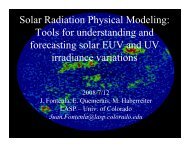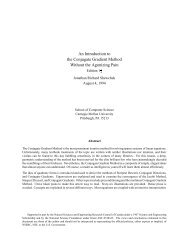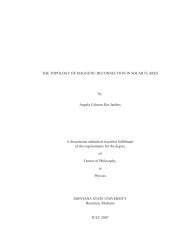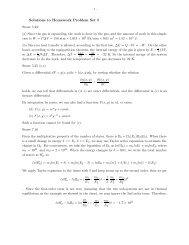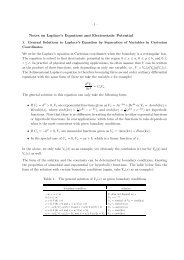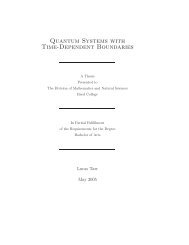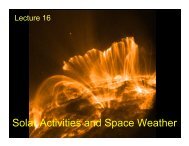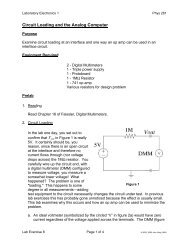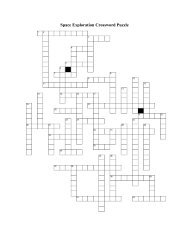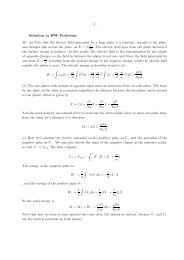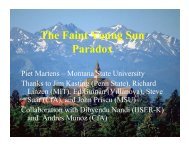Magara, T., Shibata, K., & Yokoyama, T. 1997, ApJ, 487, 437
Magara, T., Shibata, K., & Yokoyama, T. 1997, ApJ, 487, 437
Magara, T., Shibata, K., & Yokoyama, T. 1997, ApJ, 487, 437
Create successful ePaper yourself
Turn your PDF publications into a flip-book with our unique Google optimized e-Paper software.
438 MAGARA, SHIBATA, & YOKOYAMA Vol. <strong>487</strong><br />
and the related problems and give our conclusions. The<br />
Ðnal section is devoted to summary.<br />
2. BASIC FORMULATIONS<br />
2.1. Basic Equations<br />
We consider the magnetized atmosphere composed of<br />
both the magnetic Ðeld and the ideal gas. The e†ect of<br />
the gravity is neglected for simplicity. Using the Cartesian<br />
coordinates, the basic equations are<br />
Lo<br />
] $ Æ (o¿) \ 0 , (1)<br />
Lt<br />
o CL¿ Æ$)¿D Lt ] (¿ \[$P] 1 ($ÂB)ÂB , (2)<br />
4n<br />
B AP<br />
] (¿ Æ$)<br />
BD g \<br />
oc<br />
c [ 1<br />
C L<br />
Lt<br />
AP<br />
oc<br />
oc<br />
o $ ÂBo2 , (3)<br />
4n<br />
LB<br />
\ $ Â (¿ ÂB)[$Â(g$ÂB) , (4)<br />
Lt<br />
P \ oRT<br />
k . (5)<br />
In addition, we use $ Æ B \ 0 as an initial condition for<br />
equation (4). Here all the symbols, such as P, o, T , ¿, and B,<br />
have their usual meanings, c is the adiabatic index, R is the<br />
gas constant, k is the mean molecular weight, and g is the<br />
magnetic di†usivity. All physical values are dependent on<br />
both the x and z coordinates, but constant along the y-<br />
coordinate. In practice, calculations are performed for the<br />
nondimensional values normalized by some particular<br />
units. These units are summarized in Table 1.<br />
2.2. Initial ConÐguration<br />
Initially we assume a linear force-free Ðeld described by<br />
B x<br />
\[ 2L<br />
nH B 0 cos A n<br />
2L xB e~z@H , (6)<br />
S A B \[ 1[ A2L B2 B0 cos n xB e~z@H , (7)<br />
y nH 2L<br />
B z<br />
\ B 0<br />
sin A n<br />
2L xB e~z@H , (8)<br />
where L is the horizontal scale length and is taken as the<br />
normalized length unit (L \ 1.0); H means the vertical scale<br />
TABLE 1<br />
UNITS FOR NORMALIZATION<br />
Physical Values Normalization Units Typical Values<br />
Length ..................... La 5000 (km)<br />
Velocity .................... C b 300 (km s~1)<br />
S0<br />
Time ........................ L/C 20 (s)<br />
S0<br />
Density ..................... o 10~14 (g cm~3)<br />
0<br />
Pressure .................... o C2 10 (dyne cm~2)<br />
Temperature ............... kC 0<br />
2 S0<br />
/cR 3 ] 106 (K)<br />
Magnetic Field ............ (8no S0<br />
C2 /cb )1@2 8 ] 102 (G)<br />
Electric Field .............. C (8no 0 S0<br />
C2 0<br />
/cb )1@2/c 2 ] 104 (V m~1)<br />
Magnetic Di†usivity ...... C S0<br />
L 0 S0 0<br />
5 ] 1016 (cm2 s~1)<br />
S0<br />
NOTE.ÈThe parameters o , T , and C are taken to be the coronal<br />
values in the active region. c, 0<br />
k, b 0<br />
, R, and S0<br />
c are the adiabatic index, the<br />
mean molecular weight, the plasma 0<br />
beta, the gas constant, and the speed of<br />
light, respectively.<br />
a L is a half-length between the footpoints of a loop.<br />
b C is the adiabatic sound velocity deÐned by C 4 (cRT /k)1@2.<br />
S0<br />
S0 0<br />
height of the magnetic Ðeld. For the present study, H ranges<br />
from 2L /n to O, where H \ 2L /n corresponds to the potential<br />
Ðeld and H \ O corresponds to the open Ðeld. Usually,<br />
a linear force-free Ðeld is characterized by a constant<br />
parameter a, where<br />
$ ÂB\aB , (9)<br />
and this value is described by a \ [(n/2L )2[(1/H)2]1@2 in<br />
our formulation. Therefore, a ranges from 0 (potential Ðeld)<br />
to n/2L (open Ðeld). A linear force-free Ðeld is the lowest<br />
energy state for the given boundary conditions with prescribed<br />
helicity (see Heyvaerts & Priest 1984), but in reality<br />
the coronal magnetic Ðeld is not always considered to be in<br />
this state (Schmieder et al. 1996). This is because the relaxation<br />
time to this state is not so short as the dynamical time<br />
(see Browning & Priest 1986). However, in the present study<br />
we start with this state for simplicity.<br />
The gas pressure P is uniform (P \ P ), and the ratio of<br />
this to the magnetic pressure is deÐned 0<br />
as b 4 8nP /B2<br />
(plasma b). The gas density o is uniform (o \ o ) except 0<br />
in<br />
the bottom region where it is 10 times higher 0<br />
than elsewhere.<br />
This region is modeled on the massive layers of<br />
the solar atmosphere, such as the chromosphere and the<br />
photosphere. Therefore, the gas pressure and density are<br />
expressed by<br />
P \ P 0<br />
, (10)<br />
o<br />
\ 4.5Mtanh [[50(z [ 0.1)] ] 1N ] 1 , (11)<br />
o 0<br />
respectively. Plasma b is also expressed by<br />
b \ P 0<br />
(B2/8n) \ P 0<br />
(B2/8n)e~(2z@H) \ b e(2z@H) . (12)<br />
0 0<br />
In the present study, we adopt b \ 0.2, c \ 5/3, P \ 1/c,<br />
0 0<br />
o \ 1, and B \ (8nP /b )1@2 \ (8n/cb )1@2. From now on,<br />
0 0 0 0 0<br />
all physical values presented in this paper are normalized by<br />
the units in Table 1.<br />
Finally, the temperature is deÐned by<br />
in the nondimensional form.<br />
T \ c P o , (13)<br />
2.3. Boundary Conditions<br />
Figure 1 illustrates the domain of the present numerical<br />
simulation. This Ðgure also shows the initial conÐguration<br />
of the magnetic Ðeld lines projected onto the (x, z) plane. We<br />
set a free boundary condition at the upper boundary (at<br />
z \ 40),<br />
LB x<br />
Lz \ LB y<br />
Lz \ Lv x<br />
Lz \ Lv y<br />
Lz \ Lv z<br />
Lz \ LP<br />
Lz \ 0, $ÆB\0, (14)<br />
and antisymmetric boundary conditions both along the<br />
z-axis (at x \ 0) and along the side boundary (at x \ 8),<br />
v x<br />
\ v y<br />
\ B z<br />
\ Lv z<br />
Lx \ LB x<br />
Lx \ LB y<br />
Lx \ LP<br />
Lx \ Lo<br />
Lx \ 0 , (15)



